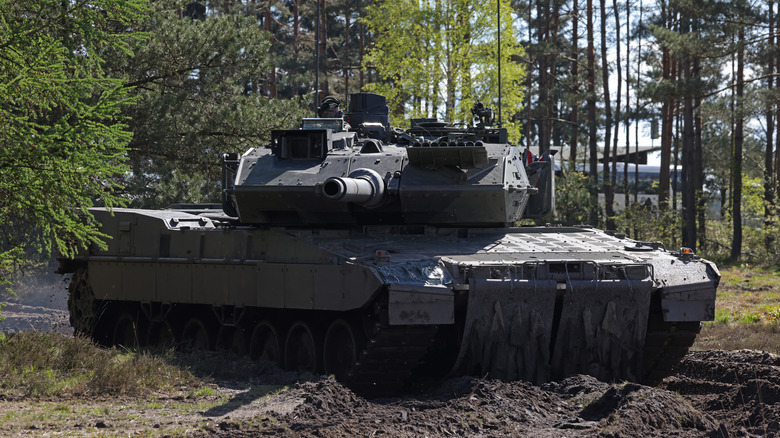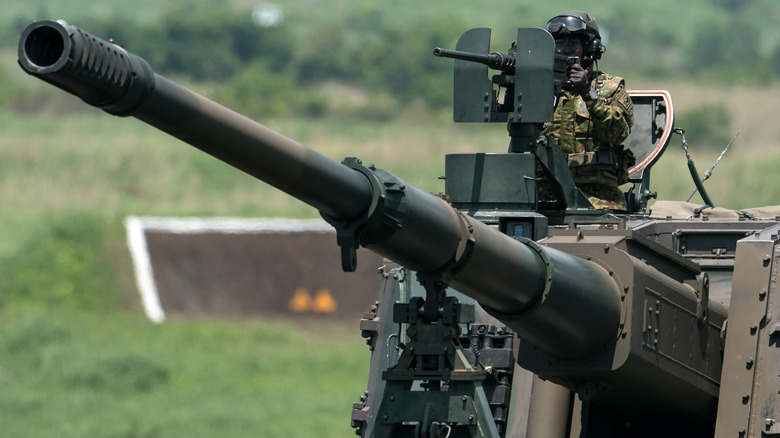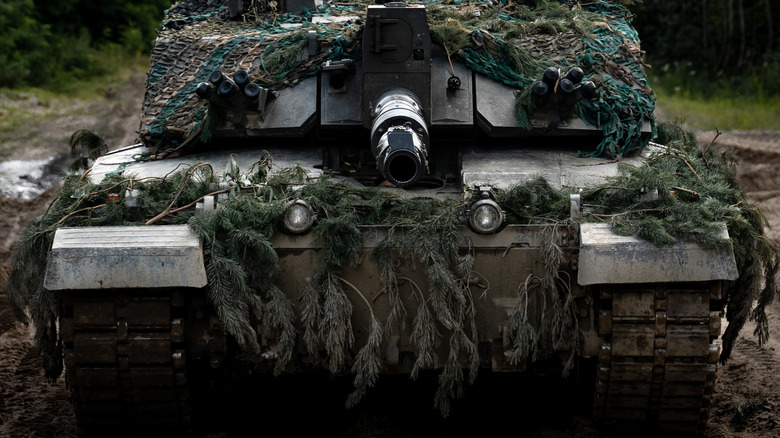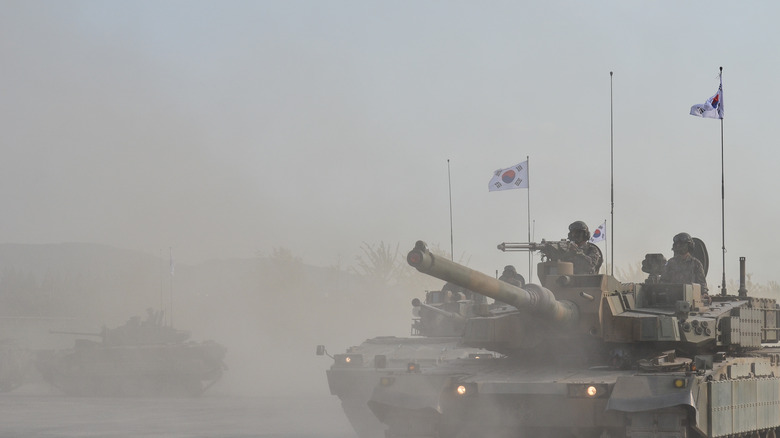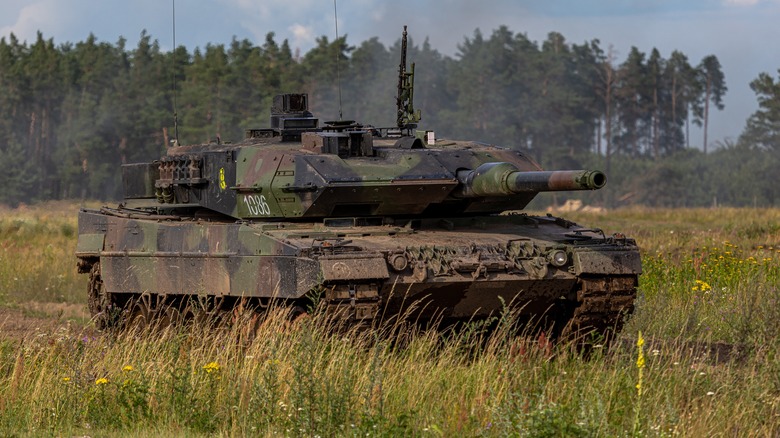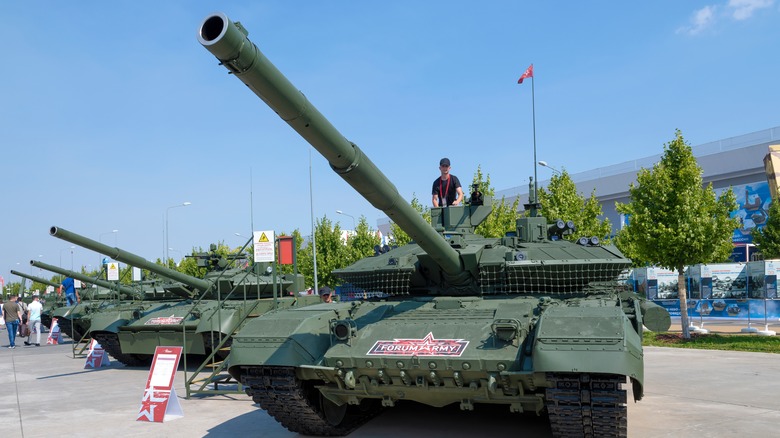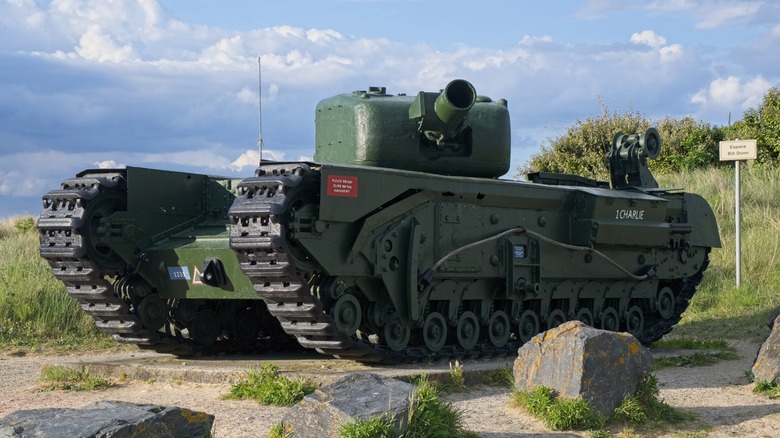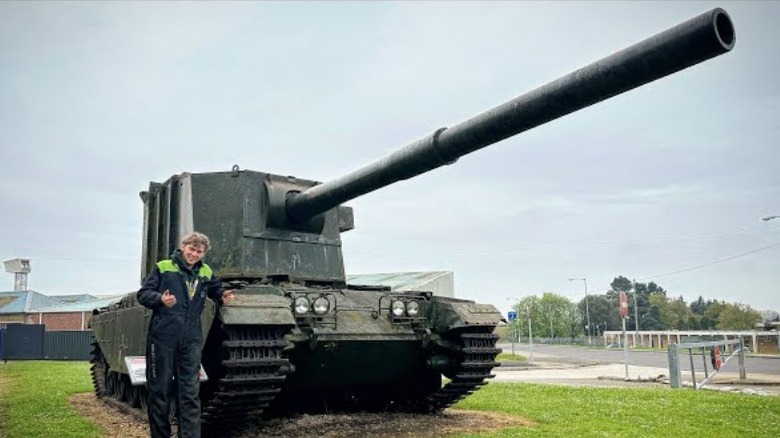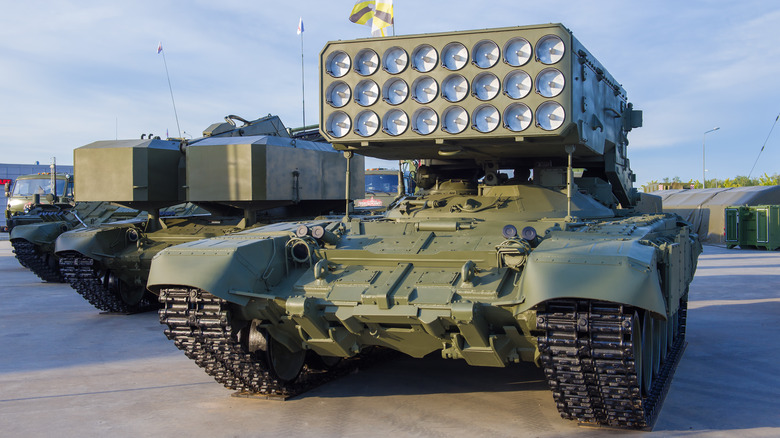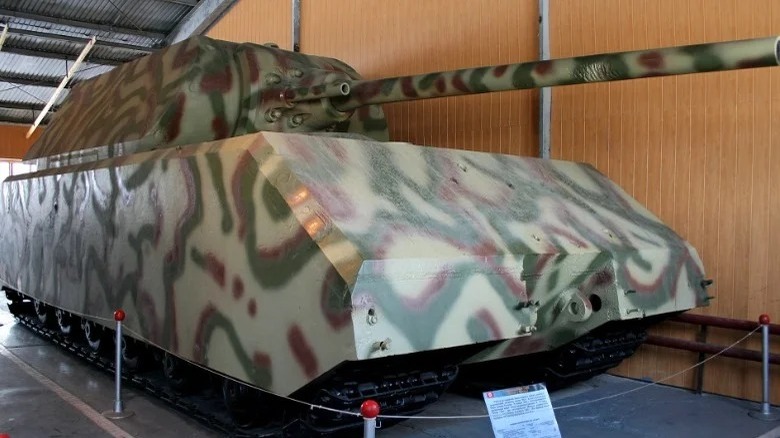10 Of The Most Heavily Armed Tanks Of All Time
Among the many vehicles and weapon systems used in militaries worldwide, tanks are generally among the most powerful. These armored vehicles are essentially large artillery guns mounted on top of an impregnable chassis that can travel over almost any terrain. While tanks also have other weapons, typically in the form of missile launchers and machine guns, the main turrets are usually the most powerful and important.
As tanks have developed with thicker and stronger armor as well as new types of active and passive protection systems, the weapons have also needed upgrades to keep up. Often, this means adding extra lethality by including more powerful weapons capable of penetrating even the best armor. In some cases, manufacturers may even sacrifice defensive elements and speed to concentrate fully on offensive capabilities.
While it is difficult to properly judge how powerful each tank is, as military forces often keep exact specifications shrouded in secrecy, publicly available information can give a good idea of how heavily armed each tank is.
Chinese Type 99
The Type 99 is a Chinese-made main battle tank that goes by several names, including the official designation ZTZ-99. Developed as a replacement for the earlier Type 88 tanks, it now makes up a significant part of the Chinese military force's armored divisions alongside the smaller and less powerful Type 96. There are now over 1,000 Type 99 tanks in service, and production shows no sign of slowing down any time soon as China continues to expand its military forces.
Now more than two decades old, the Type 99 has seen several major revisions and upgrades. While much of the technology was originally based on the T-72 tank, it can now compete with established tanks from other countries, including the American M1 Abrams, the British Challenger 2, and the Russian T-90. Weighing in excess of 50 tons, it is one of the heaviest modern main battle tanks still in use today.
The main weapon of the Type 99 is a ZPT-98 125 mm smoothbore gun, complete with a two-plane stabilization system and an autoloader. Capable of firing up to eight rounds a minute and launching anti-tank missiles, long dart penetrating rounds, and high explosive ammunition, it has a lot of firepower. The armored vehicle also comes with two machine guns for more close-range combat.
Challenger 2
Based on the earlier Challenger 1, the Challenger 2 is a special British third-generation main battle tank. Production for the new tank began in the early 1990s and the first unit was delivered to the British Army in 1994 ahead of it officially entering service in 1998. From that time, the Challenger II has been the tank of choice of the U.K.'s military in theaters around the world, involved in operations in locations such as Iraq, Afghanistan, and Kosovo.
While not particularly fast, the Challenger II is focused almost entirely on being able to withstand enemy fire and deliver a lethal amount of damage as quickly as possible. In British hands, the tank has been a force to be reckoned with and the only Challenger II tanks lost to enemy fire throughout its entire history have come during the ongoing war in Ukraine. That helps put into perspective just how powerful and deadly the tank can be.
That lethality largely comes from the 120 mm L30 rifled gun, which acts as the primary weapon of the tank and can fire a variety of rounds. These include L31 high explosive squash head, L27A1 armor-piercing fin-stabilized discarding sabot (APFSDS), and white phosphorus smoke rounds. To add some extra fire support in close range, the vehicle also comes equipped with two 7.62mm chain guns.
K2 Black Panther
The K2 Black Panther is a relatively modern main battle tank. Unlike reliable stalwarts such as the M1 Abrams, Leopard 2, and Challenger 2, it only entered service in the last decade and has relatively little experience in actual combat. But that shouldn't take away from the power of the South Korean armored vehicle, which has been designed to help protect the country against possible hostilities from its neighbor to the North.
This has necessitated a specific philosophy for the K2 Black Panther. The tank was created to be fast and powerful so it could quickly move in and hit targets. This hit-and-run approach is vital in a fast-paced and volatile environment like the DMZ at the border between North and South Korea. To be able to pull off these kinds of tactics, the K2 Black Panther has an integrated KSTAM-II targeting system and a Leclerc advanced fire control system. These allow the tank to quickly find and lock on to enemies.
The main weapon of this particular tank is a 120-millimeter L/55 smoothbore gun developed by Hyundai, which can fire up to 10 rounds each minute for a maximum of 40 shells. It shoots out these rounds at extreme speed and can hit a tiny 1-foot target at a range of up to .62 miles (1 km). Secondary armaments include a 12.7×99mm K6 heavy machine gun and a 7.62×51mm machine gun.
Leopard 2A8
As a main battle tank, the Leopard 2 tank is among the most successful tanks of the modern era and has ensured they are not useless. A direct competitor to the likes of the Challenger 2 and M1 Abrams, this third-generation tank acts as the backbone of the German army. The design process for the tank began in the 1970s, and it entered service in 1979, right in the middle of the Cold War. Since that time, the tank has gone through numerous revisions, and thousands of them have been produced, with many being exported to countries across the globe.
The most recent variant of this tank is the Leopard 2A8, a $30 million monster that is arguably the most expensive tank on the market. Like its predecessors, it is intended to be a superior tank jam-packed with technology and features. The original version of the Leopard 2 was developed to outgun and outmaneuver armored vehicles fielded by Soviet forces in Europe, and this design philosophy continues today.
The main weapon for the Leopard 2A8 is a 120mm main cannon. This particular smoothbore weapon is particularly effective because it has a unique stabilization system that means it can be fired while the tank is moving at high speeds. It also comes equipped with two 7.62-millimeter machine guns and fires the powerful Rheinmetall DM53 and DM63 rounds, which can penetrate up to 750 millimeters of armor.
KF51 Panther
The German KF51 Panther is essentially a modified version of a Leopard 2A4 outfitted with a new gun. Designed and manufactured by Rheinmetall, this main battle tank is not yet in operation, but it has been demonstrated to the public and has gone through testing. It is intended to replace the Leopard 2 and offer a more futuristic tank for modern warfare. The ultimate aim of the designers is to create a tank that integrates with advanced battle systems, protects against a wide range of threats, and provides a larger threat.
This means that the KF51 Panther comes equipped with a variety of defensive systems intended to provide more active protection to keep the tank light and agile. Utilizing a fully digitized architecture, the tank is packed with sensors to detect incoming threats and deploy countermeasures, rather than simply relying on thick and heavy armor.
However, the main difference between the KF51 Panther and most other NATO armored vehicles is that it boasts a Rh-130 L/52 130 mm smoothbore gun. This is a departure from the commonly used 120 mm guns by most operators. Designated the Future Gun System, it has a significantly longer kill range and is backed up by a large 12.7 mm coaxial machine gun, a 7.62 mm machine gun, and four quadcopter drones.
T-90M Tank
Until the introduction of the T-90 tank and the end of the Soviet Union, armored divisions of the Russian military forces had been made up of the T-72 since its introduction in 1969. Uralvagonzavod was tasked with creating a successor that would be able to meet the challenges of modern warfare and compete against NATO's forces. It entered active military service in 1992 and has since seen combat in a wide range of combat arenas, including Azerbaijan and Ukraine.
The T-90 has proven vulnerable to attack, particularly in Ukraine where RPGs and other smaller armaments have been able to destroy dozens of them. However, even with those defensive weaknesses, the Russian armored vehicle can certainly pack a punch. It comes equipped with a 125 mm 2A46 smoothbore main gun, slightly bigger than the main guns on most NATO tanks. Aided by the 1A45T fire-control system, it can fire a range of rounds, such as APFSDS, high explosive rounds, and anti-tank missiles.
Like most other main battle tanks, the Type-90 comes with smaller mounted weapons, including a 12.7mm heavy machine gun and a 7.62mm PKMT. An upgraded version of the tank that first entered service in 2020 is the T-90M. This comes with a slightly more powerful main gun in the form of the 2A46M-4, which is more accurate and can hit targets at a longer range.
Churchill AVRE
Following the failure of Allied forces at the Dieppe raid, where tanks were bogged down by enemy fire and obstacles on the beach, British commanders recognized the need for an armored vehicle to protect engineers. The result of this was the creation of several Armoured Vehicle Royal Engineers (AVREs). These were essentially tanks operated by members of the Royal Engineers that provided necessary protection on the battlefield so they could perform their duties. Among them, the Churchill AVRE was likely the most well-known and one of the earliest examples.
After multiple revisions, later versions of the Churchill AVRE proved effective at crossing terrain that other tanks could not pass. It also had some of the thickest and strongest armor of even the most legendary tanks of World War II, but it was incredibly heavy, meaning it could only move at slow speeds.
Fortunately, it didn't have to move quickly and had a main gun capable of dealing a huge amount of damage. The main gun — with the official name Mortar, Recoiling, Spigot, 29mm — was known as the dustbin because of its ability to damage a wide area in a single shot. This 230 mm petard spigot mortar fired a 40-pound explosive designed to destroy any obstacles and allow other tanks to pass through the wreckage.
FV4005
During the 1940s, leaders within the British army recognized that heavier and more powerful tanks would be needed to combat the ever-growing forces of the Soviet Union. Following the introduction of the IS-3 in 1945, work began on what would ultimately become the FV4005. This new tank needed to be able to fire rounds that could penetrate up to six inches of steel armor plating sloped at up to 60 degrees from a range of at least 2,000 yards.
The tank featured a main gun known as the 183 mm calibre L4A1. Although a dedicated chassis had also been developed to mount this new weapon, a need to mass-produce the tanks led to it also being fixed to existing Centurion tank hulls that were available at the time. Introduced in 1955, the FV4005 never left the testing stage, but it had one of the largest guns ever attached to a tank.
Weighing over three tons, the 183 mm L4A1 fired a high-explosive squash head shell, also known as HESH, that was 145 pounds and almost 30 inches long. Firing the round created a recoil force of 86 tons. The size and weight of the ammunition meant that the FV4005 could only carry 12 rounds and the sheer power of the gun meant it was only accurate at short range. Ultimately, it was discontinued just two years later in 1957.
TOS-1
The TOS-1 is a cross between a traditional multiple-launch rocket system and a continuous track tank. Known in Russia as a Heavy Flamethrower System, the TOS-1 entered development in the early 1980s and subsequently entered active service in 1988. It has since been used in various combat arenas, including Afghanistan, Chechnya, and more recently Ukraine.
The tank itself is essentially a T-72 chassis that is heavy and strong enough to support the deadly rocket launchers that sit atop it. Uniquely, these launchers can fire thermobaric missiles, an incredibly powerful weapon that has proven controversial. Thermobaric explosives cause damage by creating a vacuum and blast wave that is capable of vaporizing people and completely destroying structures.
These weapons work by releasing a cloud of flammable material that can penetrate a wide area before a second explosion ignites the cloud. This quickly consumes all the oxygen in the surrounding area, creating a blast that is only outmatched by nuclear warheads. The TOS-1 can fire these rockets at a range of up to five and a half miles.
Panzer VIII Maus
It shouldn't be surprising that the Panzer VIII Maus had one of the most powerful guns on any tank ever created. This particular armored vehicle also has the distinction of being the largest and heaviest tank of all time. Weighing a staggering 188 tons, it is significantly bigger than any other tank that has ever been built.
However, the Panzer VIII Maus never saw any combat action. The Nazis only began production of the tank in 1944, a few months before World War II would end, and Russian soldiers captured the only two completed versions during the combined push into Germany by Soviet and Western Allied forces.
The standout weapon of the Panzer VIII Maus was its main gun, known as the 128 mm KwK 44 gun L/55. The weapon was a modified version of the 12.8 cm Pak 44 anti-tank artillery and was powerful enough to destroy any vehicle fielded by Germany's enemies. It also featured a howitzer tank gun in the form of the 75 mm KwK 44 gun L/36.5 and a 7.92 mm machine gun.
[ Featured Image by Superewer via Wikimedia Commons | Cropped and scaled | CC BY-SA 4.0 ]
